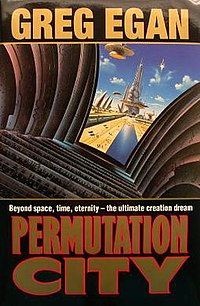Permutation City: Difference between revisions
Put a link to the author's webpage about this novel that's all |
No edit summary |
||
| Line 37: | Line 37: | ||
==Links== |
==Links== |
||
* [http://gregegan.customer.netspace.net.au/PERMUTATION/Permutation.html |
* [http://gregegan.customer.netspace.net.au/PERMUTATION/Permutation.html Permutation City page in Greg Egan's own website] |
||
==See also== |
==See also== |
||
Revision as of 22:28, 17 August 2007
This article is written like a review. |
 Cover of first edition (hardcover) | |
| Author | Greg Egan |
|---|---|
| Language | English |
| Genre | Science fiction novel |
| Publisher | Millennium Orion Publishing Group |
Publication date | 1994 |
| Publication place | Australia |
| Media type | Print (Hardcover & Paperback) |
| Pages | 310 pp |
| ISBN | ISBN 1-857-98174-X Parameter error in {{ISBNT}}: invalid character |
Permutation City is a 1994 science fiction novel by Greg Egan which explores quantum ontology via the various philosophical aspects of artificial life and simulations of intelligence. It won the John W. Campbell Award for the best science-fiction novel of the year in 1995 and was nominated for the Philip K. Dick Award that same year. The novel was cited in a 2003 Scientific American article on multiverses by Max Tegmark.
Plot summary
Permutation City deals with the same kind of philosophical questions as other works such as Blade Runner and Ghost in the Shell, as well as other cyberpunk and postcyberpunk works – is there any difference between a perfect computer simulation and a "real" person? – but pushes much further the paradoxes arising from the assumption of the artificial reproducibility of the human mind. Moving from here, through rigorous arguments, Egan gleefully deconstructs and undermines not only the traditional notions of self, future, personality, but of physical reality itself. Eventually, Egan formulates the "dust" theory of reality, arguing that our universe could be but an algorithm running without the need of any physical substrate.
Further Egan novels which deal with uploaded personalities include Diaspora and Schild's Ladder.
The book opens with a 20 line anagrammatic poem, in which all lines are anagrams of the book's title.
Another interesting idea expressed in the novel is that of the Autoverse, an artificial life simulator ultimately based on a cellular automaton complex enough to represent the substratum of an artificial chemistry. The Autoverse is a clockwork Newtonian chemistry set, internally consistent and vaguely resembling real chemistry. In the novel, tiny environments - simulated in the Autoverse and filled with small populations of a simple artificial lifeform- are opposed to huge virtual realities making heavy use of heuristics and therefore intrinsically incoherent.
Egan also explores the meaning of solipsism through the concept of "Solipsist Nation" that is developed by a "Copy" (computer simulation of a "real" person). Since every "Copy" is aware that they are a simulation in a virtual reality, the philosophical ideas from this sub-plot present an unusual and fascinating twist on the concept.
